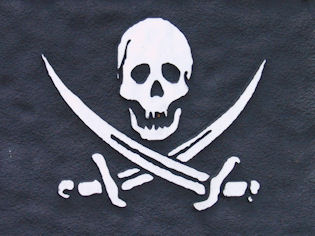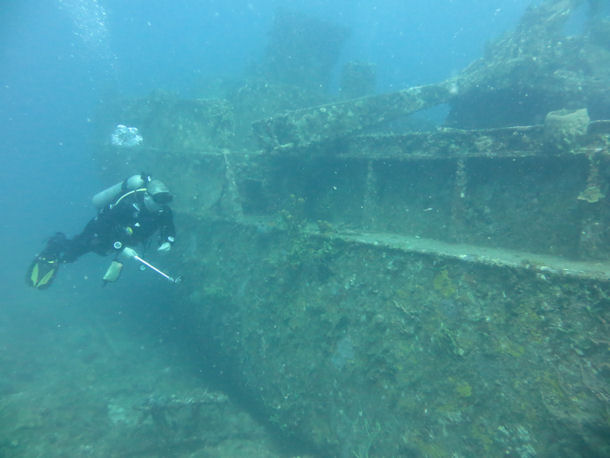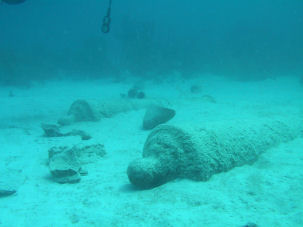by Steven Blum
The Legend of RMS Rhone
|
|
RMS Rhone is one of the most popular divable Caribbean wreck dive sites. The mail carrier and passenger ship sunk during a hurricane near Salt Island, a part of the British Virgin Islands in October 1867. Her wreckage was featured in the 1977 underwater thriller “The Deep” which starred Nick Nolte and Jaqueline Bisset. The wreck and the area around is now a national park and and has been a main attraction for scuba divers and snorkelers from all over the world.
|
|
The wreck's maximum depth is 85 feet (26 m) of water
|
|
The 310 foot (94 m) long and 40 foot (12 m) wide trim, two-masted, single funnel brig with an iron hull was built in 1865 and had a net tonnage of 2.738 tons. The passenger capacity was 253 first class, 30 second class and 30 third class. The ship engine was an innovative idea for the 20th century. The RMS Rhone was the first ship equipped with a surface condenser in order to save and re-use water in her boilers and steam engine. She had also a bronze propeller, which was only the second ever made of this alloy. Owned by the Royal Mail Steam Packet Company, propeller driven vessel made her maiden voyage from Southhampton to Brazil in 1865.
|
|
As of 1867 the RMS Rhone was served to transport mail and passengers from and to the Caribbean. The UK Royal Mail Ship proved her seakeeping ability by weathering several severe storms during several trips.
|
|
October. Hurricane season. The morning of October 29, the day of the sinking, was deceiving with clear skies and calm seas. The RMS Rhone stayed alongside RMS Conway for bunkering of coal stocks at Great Harbour, Peter Island for the return trip to Southampton, UK. Ordinarily, the ship would have been at Charlotte Amalie, St. Thomas, US Virgin Islands, to prepare for the trans-Atlantic voyage. But with an outbreak of yellow fever in St. Thomas, the Royal Mail Packet Steam Company used Road Harbor, Tortola, and Great Harbor, Peter Island as substitute ports.
|
|
It was about eleven o’clock, as the captains of Conway and Rhone became wary when the barometer suddenly fell and skies darkened. The weather turned bad around. The Rhones Captain Sir Robert F. Wooley dismissed the strong north winds and driving rain as an normal Atlantic storm, since it was well past hurricane season. Captain Hammock, commander of the Conway, agreed. As the wind increased and the storm was brewing, they knew that it was time to leave the harbour to move the Rhone and the Conway to a safer locale. They decided to transfer the passengers from Conway to the "unsinkable" Rhone; Conway was then to head for Road Town Harbour and Rhone would sail on the open sea to protect the ship.
|
|
The Conway departed quickly, but was hit by the hurricane, severely damaged, then blown onto Tortolas shore.
The Rhones anchor caught on something during the hasty departure. Captain Wooley was forced to abandon the 3000 pound anchor and its 300-foot-chain in Great Harbour. The ship was in open water without an anchor when the hurricane struck with strong south winds. Even with the steam engines at full speed, the hurricane-force winds and high waves overpowered the ship. Wooley was washed overboard and the ship crushed into the western tip of Salt Island. Sharp boulders ripped a hole in the ships iron hull. The vessel broke in two and disappeared in a flash. Survivors either swam to the island or clung to the masts and wreckage jutting out of the shallow water.
|
|
Had it not been for the threat of yellow fever on St. Thomas, the Rhone would have avoided its fate and been in a much safer refuge.
|
|
Her wreckage was also featured in the 1977 filming of The Deep, including the famous scene of Jacqueline Bisset diving in a T-shirt.
Quellen:
Fred Dembny, Tauchreiseführer Puerto Rico, Delius Klasing Edition Nagelschmid, Verlag Stefanie Nagelschmid, Stuttgart (1995), S. 92 - 100.
Wikipedia
|
|
|
Das könnte Sie auch interessieren:
|

Wreck Alley - Die Straße der Wracks (Tortola - British Virgin Islands)
Dieser Tauchplatz vor den British Virgin Islands besteht aus dem Wrack des Frachtschiffs Marie L, das Anfang der 1990er Jahre absichtlich als künstliches Riff versenkt wurde, der Pat, einem Schlepper, der wenige Jahre später parallel zur Marie L. gesunken ist, der Beate (gesunken 2001) und der Island Seal (versenkt 2009). Etwas nördlich liegt in 26 m Tiefe noch das Wrack des 40 m langen Frachters Inganess Bay...
[mehr]
|
|
|

Von Silberschiffen und Piratenschätzen (Reisebericht)
Piraaaateeeeeen!!! Dieser Schrei war gefürchteter als Stürme oder Skorbut. Um die Wende vom 17. zum 18. Jahrhundert war die Karibik Zentrum der Seeräuberei. Auf den Inseln entstanden zahllose Festungen, Kanonenkugeln flogen, Schatzschiffe sanken, es wurde geplündert und geraubt. Es waren verrückte Jahrzehnte, in denen all die irren Typen auftauchten, die noch heute durch Abenteuerbücher und –filme geistern. Wo immer ich während meiner Karibik-Rundreise an Land ging, hörte ich Geschichten von versunkenen Galeonen und sagenhaften Piratenschätzen...
[mehr]
|
|

Der Jahrhundertschatz - Mel Fisher entdeckte vor 30 Jahren das Wrack der ATOCHA (USA)
Mel Fisher (1922 ? 1999) gilt als der berühmteste Schatzsucher der Welt. Unermüdlich widmete er sich der Suche nach versunkenen Schätzen vor der Küste Floridas. Gemeinsam mit Kip Wagner suchte er die versunkene spanische Silberflotte von 1715. Sie waren erfolgreich und bargen spanische Golddublonen, Silberpiaster, Silberbarren und eine Vielzahl kostbarer Schmuckstücke.
[mehr]
|
|

Tauchen am Wrack der Veronica L (Grenada)
Ein beliebtes Tauchziel vor Grenada ist das Wrack der VERONICA L. Der kleine, etwa 40 m lange Frachter sank vor einigen Jahren unweit des Hafens der Inselhauptstadt St. Georges. Die VERONICA L liegt in etwa 15 m Tiefe aufrecht auf dem Kiel auf dem Boss Riff. Das langestreckte Riff fällt bis auf 24 m Tiefe ab. Die Silhouette des Wracks hebt sich deutlich vom Blau des Meers ab.
[mehr]
|
|

Die Kanonen der Nuestra Señora de Guadalupe (Dominikanische Republik)
Vor der Küste Hispaniolas, der heutigen Dominikanischen Republik und Haiti, befindet sich ein ausgedehntes Korallenmassiv, welches so mancher spanischen Galeone zum Verhängnis wurde. Etwa 50 Schiffe, zum Teil reich beladen mit Gold- und Silberschätzen und Edelsteinen, sollen an diesem Riffgebiet gesunken sein...
[mehr]
|
|
|
|

